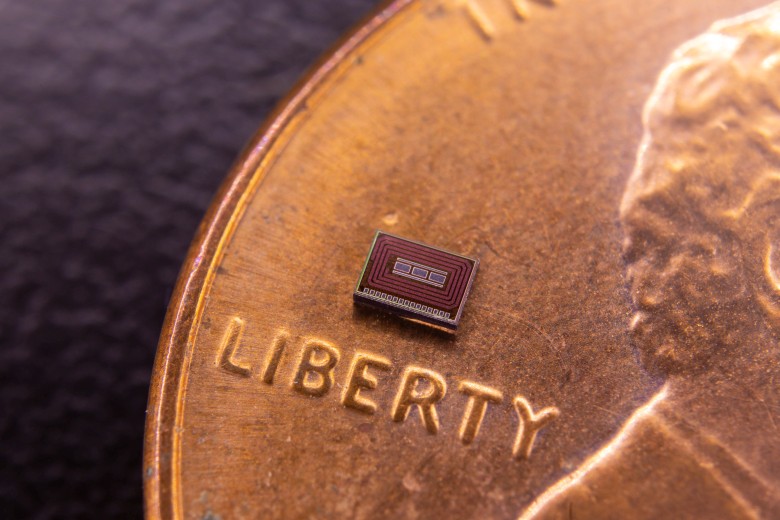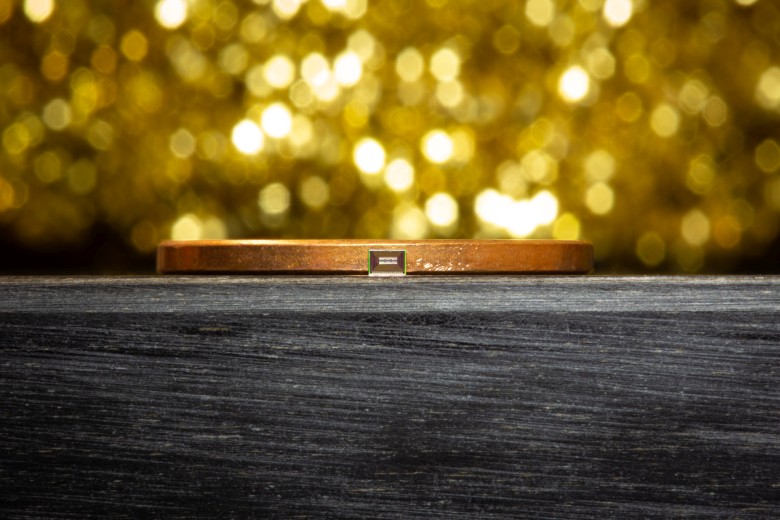 A 0.85 × 1.5 mm subcutaneous sensor for monitoring the blood alcohol concentration against the background of a one-cent coin with a diameter of 19 mm. Photo: David Baillot / UC San Diego Jacobs School of Engineering
A 0.85 × 1.5 mm subcutaneous sensor for monitoring the blood alcohol concentration against the background of a one-cent coin with a diameter of 19 mm. Photo: David Baillot / UC San Diego Jacobs School of EngineeringContinuous monitoring of blood alcohol concentration is an important task, the solution of which could save millions of lives. If monitoring is carried out automatically with wireless data transmission, then such a sensor is easily connected to the vehicle control system - and a person with a blood alcohol concentration above the permissible level will never sit behind the wheel of a car. The engine just won't start.
Moreover, at the request of the carrier, such sensors can automatically send information to law enforcement agencies and ambulance to automatically respond to extreme alcohol concentrations. It is no secret that a significant proportion of serious crimes and suicides are committed while intoxicated. Such monitoring will also save many lives.
University of California at San Diego engineers have developed a
miniature ultra-low-power
implantable biosensor that can be used for continuous, long-term monitoring of alcohol. The chip is small enough to be implanted into the body just below the surface of the skin and powered by a wireless wearable device — for example, from a smartphone, smart watch, or other wearable device.
A miniature chip size of 0.85 × 1.5 mm requires only 970 nanowatts for operation. Data transmission is carried out by the
backscattering method (the measurement time is no more than three seconds). In principle, such a small amount of energy can be extracted directly from the human body: for example, by decomposing sugar in the blood, or according to the temperature difference between the internal and external circuits of the microcircuit. Or from various background sources: vibration, radio waves, and so on. But in this case, the developers have implemented the easiest way to obtain energy from a permanent external transmitter, which can be any electronic gadget or wearable electronics.
 The sensor is compared with a one-cent coin edge 1.55 mm thick. Photo: David Baillot / UC San Diego Jacobs School of Engineering
The sensor is compared with a one-cent coin edge 1.55 mm thick. Photo: David Baillot / UC San Diego Jacobs School of Engineering“The ultimate goal of this work is to develop a permanent, unobtrusive device for monitoring alcohol and drugs for patients in drug treatment programs,”
said project leader Drew Hall, a professor of electrical engineering at UC San Diego Jacobs School of Engineering. Drew Hall also collaborates with the
Center for Wireless Communications and
the Wearable Sensor Center , which operates at the University of California at San Diego.
One of the problems for patients in addiction treatment programs is the lack of convenient tools for continuous monitoring. The most common way to assess the level of alcohol in the blood is breathalyzers, rather clumsy devices. To use them, you need to come into contact with the patient and ask him for assistance, which is not always possible and convenient to do. In addition, breathalyzers give not very accurate results, and they can be deceived. A blood test is the most accurate method, but it must be performed by a qualified technician.
As an alternative method of measuring the level of alcohol in the blood, it was proposed to use special tattoos on the body with built-in alcohol sensors, however, they are not without drawbacks. Such tattoos are easy to remove - and they are intended for one-time use (that is, the tattoos themselves are temporary). According to the developers of the new sensor, subcutaneous injection is the most reliable option for long-term and accurate tracking of the level of alcohol in the blood for many months and years.
 Subcutaneous sensor compared to the penny and the tip of the biopsy needle size 16G (1.65 mm). Photo: David Baillot / UC San Diego Jacobs School of Engineering
Subcutaneous sensor compared to the penny and the tip of the biopsy needle size 16G (1.65 mm). Photo: David Baillot / UC San Diego Jacobs School of EngineeringA biosensor chip with a volume of about one cubic millimeter is injected under the skin into the interstitial fluid that surrounds the cells of the body. The sensor is covered with
alcohol oxidase (EC 1.1.3.13) . This enzyme selectively interacts with alcohol and produces a by-product that can be electrochemically detected. Electrical signals are transmitted wirelessly to a nearby wearable device, such as a smart watch, which also serves as a source of wireless power for the chip. Two additional sensors on a chip measure background signals and pH levels in order to clarify alcohol concentration. Low-power voltage regulators use amperometric and potentiometric methods with a sensitivity of 2.5 nanoampr and 0.5 millivolts, respectively.
The microcircuit has already been tested in the laboratory on a mixture of ethanol in diluted human serum under layers of pig skin. Now scientists are planning to conduct experiments on live pigs. Inventors filed a patent application for this technology.
The scientific article
“A Sub-1 μW Multiparameter Injectable BioMote for Continuous Alcohol Monitoring” was presented April 10, 2018 at the
IEEE Custom Integrated Circuits Conference in San Diego.